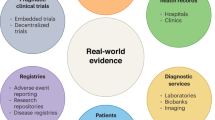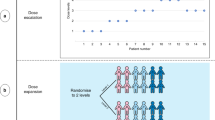Abstract
Before any clinical trial begins, a detailed trial protocol must be prepared. The authority of the trial results will depend on the quality of this document. In many protocols, a key component is a plan for a series of interim analyses of the accumulating trial data, and a 'stopping rule' based on them. Such a rule might be intended to prevent participants from continuing to receive a drug that already seems to be unsafe, or to allow a successful drug to become generally available as soon as sufficient evidence of its advantages has been collected. There has been considerable misunderstanding of these rules, and controversies associated with them. Here, I discuss why this might be, and what can be done to promote their successful and beneficial use in the future.
This is a preview of subscription content, access via your institution
Access options
Subscribe to this journal
Receive 12 print issues and online access
$209.00 per year
only $17.42 per issue
Buy this article
- Purchase on Springer Link
- Instant access to full article PDF
Prices may be subject to local taxes which are calculated during checkout
Similar content being viewed by others
References
Horrobin, D. F. Are large clinical trials in rapidly lethal diseases usually unethical? Lancet 361, 695–697 (2003).
Sooriyarachchi, M. R. & Whitehead, J. A method for sequential analysis of survival data with nonproportional hazards. Biometrics 54, 1072–1084 (1998).
Goss, P. E. et al. A randomised trial of letrozole in postmenopausal women after five years of tamoxifen therapy for early-stage breast cancer. N. Engl. J. Med 349, 1793–1803 (2003).
Bryant, J. & Wolmark, N. Letrozole after tamoxifen for breast cancer — what is the price of success? N. Engl. J. Med 349, 1855–1858 (2003).
Bolland, K. & Whitehead, J. Formal approaches to safety monitoring of clinical trials in life-threatening conditions. Statist. Med. 19, 2899–2917 (2000).
Lan, K. K. G., Simon, R. & Halperin, M. Stochastically curtailed tests in long-term clinical trials. Sequential Anal. 1, 207–219 (1982).
Spiegelhalter, D. J., Freedman, L. S. & Blackburn, P. R. Monitoring clinical trials: conditional or predictive power? Control. Clin. Trials 7, 8–17 (1986).
Whitehead, J & Matsushita, T. Stopping clinical trials because of treatment ineffectiveness: a comparison of a futility design with a method of stochastic curtailment. Statist. Med. 22, 677–687 (2003).
Whitehead, J. The Design and Analysis of Sequential Clinical Trials Rev. 2nd Edn. (Wiley, Chichester, 1997).
Jennison, C. & Turnbull, B. W. Group Sequential Methods with Application to Clinical Trials (Chapman and Hall/CRC, Boca Raton, 2000).
Todd, S., Whitehead, A., Stallard, N. & Whitehead, J. Interim analyses and sequential designs in phase III studies. Br. J. Clin. Pharmacol. 51, 394–399 (2001).
Peace, K. E. (ed.). Biopharmaceutical Sequential Statistical Applications (Dekker, New York, 1992)
O'Brien, P. C. & Fleming, T. R. A multiple testing procedure for clinical trials. Biometrics 35, 549–556 (1979).
Lan, K. K. G. & DeMets, D. L. Discrete sequential boundaries for clinical trials. Biometrika 70, 659–663 (1983).
Whitehead, J. in Handbook of Statistics in Clinical Oncology (ed. Crowley, J.) 211–228 (Dekker, New York, 2001).
Whitehead, J. & Todd, S. The double triangular test in practice. Pharm. Statist. 3, 39–49 (2004).
Fairbanks, K. & Madsen, R. P values for tests using a repeated significance test design. Biometrika 69, 69–74 (1982).
Tsiatis, A. A., Rosner, G. L. & Mehta, C. R. Exact confidence intervals following a group sequential test. Biometrics 40, 797–803 (1984).
MPS Research Unit. PEST Operating Manual (Univ. Reading, 2000).
Cytel Software Corporation. EaSt: A Software Package for the Design and Interim Monitoring of Group Sequential Clinical Trials (Cytel, Cambridge, 2000).
Mathsoft Inc. Splus Seq Trial (Seattle, 2000).
Speigelhalter, D. J., Abrams, K. R. & Myles, J. P. Bayesian Approaches to Clinical Trials and Health-Care Evaluation (Wiley, Chichester, 2004).
Gould, A. L. Interim analyses for monitoring clinical trials that do not materially affect the type I error rate. Statist. Med. 11, 55–66 (1992).
Gould, A. L. & Shih, W. J. Sample size re-estimation without unblinding for normally distributed data with unknown variance. Comm. Stat. Theory Meth. 21, 2833–2853 (1992).
Gould, A. L. Planning and revising the sample size for a trial. Statist. Med. 14, 1039–1051 (1995).
Kieser, M. & Friede, T. Re-calculating the sample size in internal pilot study designs with control of the type I error rate. Statist. Med. 19, 901–911 (2000).
Bauer, P. & Köhne, K. Evaluation of experiments with adaptive interim analyses. Biometrics 52, 380 (1994).
Posch, M., Bauer, P. & Brannath, W. Issues in designing flexible trials. Statist. Med. 22, 953–969 (2003).
Fisher, L. D. Self-designing clinical trials. Statist. Med. 17, 1551–1562 (1998).
Jennison, C. & Turnbull, B. W. Mid-course sample size modification in clinical trials based on the observed treatment effect. Statist. Med. 22, 971–993 (2003).
Tsiatis, A. A. & Mehta, C. R. On the inefficiency of the adaptive design for monitoring clinical trials. Biometrika 90, 367–378 (2003).
Todd, S. Sequential designs for monitoring two endpoints in a clinical trial. Drug Information J. 33, 417–426 (1999).
Todd, S. An adaptive approach to implementing bivariate group sequential clinical trial designs. J. Biopharm. Statist. 13, 605–619 (2003).
Kosorok, M. M., Shi, Y. & DeMets, D. L. Design and analysis of group sequential clinical trials with multiple primary endpoints. Biometrics 60, 134–145 (2004).
Ellenberg, S., Fleming, T. & DeMets, D. Data Monitoring Committees in Clinical Trials: A Practical Perspective (Wiley, Chichester, 2002).
Author information
Authors and Affiliations
Ethics declarations
Competing interests
J.W. is Director of the Medical and Pharmaceutical Statistics Research Unit, a self-financing, non-profit making part of the University of Reading. The unit receives sponsorship from and engages in consultancy for the pharmaceutical industry, particularly with respect to the conduct of sequential clinical trials. The Unit also markets the software package PEST for the implementation of such designs.
Related links
Rights and permissions
About this article
Cite this article
Whitehead, J. Stopping clinical trials by design. Nat Rev Drug Discov 3, 973–977 (2004). https://doi.org/10.1038/nrd1553
Issue Date:
DOI: https://doi.org/10.1038/nrd1553
This article is cited by
-
A systematic review of randomised controlled trials with adaptive and traditional group sequential designs – applications in cardiovascular clinical trials
BMC Medical Research Methodology (2023)
-
A protocol for a randomized clinical trial assessing the efficacy of hypertonic dextrose injection (prolotherapy) in chronic ankle instability
Trials (2022)
-
Statistical issues associated with terminating a clinical trial due to slow enrollment
Journal of Nuclear Cardiology (2017)
-
Portfolio Decisions in Early Development
Pharmaceutical Medicine (2012)
-
Review on clinical trials of targeted treatments in malignant mesothelioma
Cancer Chemotherapy and Pharmacology (2011)



